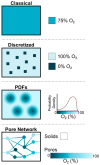Consider the Anoxic Microsite: Acknowledging and Appreciating Spatiotemporal Redox Heterogeneity in Soils and Sediments
- PMID: 37753209
- PMCID: PMC10519444
- DOI: 10.1021/acsearthspacechem.3c00032
Consider the Anoxic Microsite: Acknowledging and Appreciating Spatiotemporal Redox Heterogeneity in Soils and Sediments
Abstract
Reduction-oxidation (redox) reactions underlie essentially all biogeochemical cycles. Like most soil properties and processes, redox is spatiotemporally heterogeneous. However, unlike other soil features, redox heterogeneity has yet to be incorporated into mainstream conceptualizations of soil biogeochemistry. Anoxic microsites, the defining feature of redox heterogeneity in bulk oxic soils and sediments, are zones of oxygen depletion in otherwise oxic environments. In this review, we suggest that anoxic microsites represent a critical component of soil function and that appreciating anoxic microsites promises to advance our understanding of soil and sediment biogeochemistry. In sections 1 and 2, we define anoxic microsites and highlight their dynamic properties, specifically anoxic microsite distribution, redox gradient magnitude, and temporality. In section 3, we describe the influence of anoxic microsites on several key elemental cycles, organic carbon, nitrogen, iron, manganese, and sulfur. In section 4, we evaluate methods for identifying and characterizing anoxic microsites, and in section 5, we highlight past and current approaches to modeling anoxic microsites. Finally, in section 6, we suggest steps for incorporating anoxic microsites and redox heterogeneities more broadly into our understanding of soils and sediments.
© 2023 The Authors. Published by American Chemical Society.
Conflict of interest statement
The authors declare no competing financial interest.
Figures



References
-
- Ponnamperuma F. N. The Chemistry of Submerged Soils. Adv. Agron. 1972, 24, 29–96. 10.1016/S0065-2113(08)60633-1. - DOI
Publication types
LinkOut - more resources
Full Text Sources
Miscellaneous
